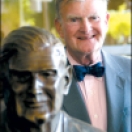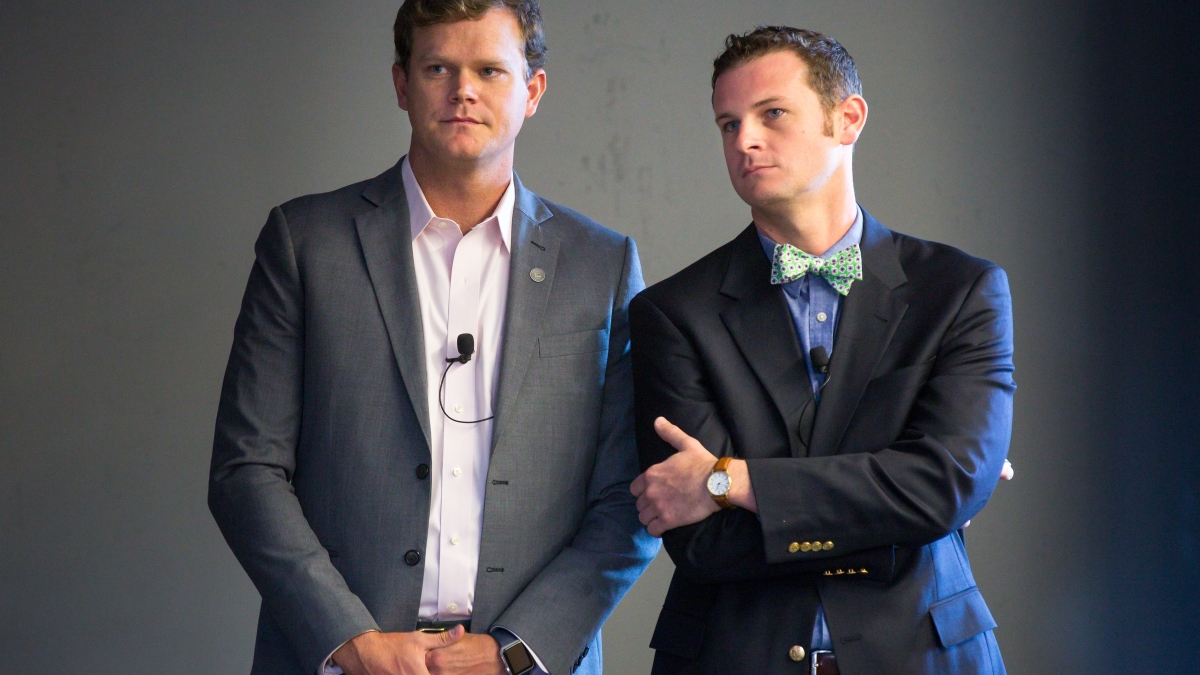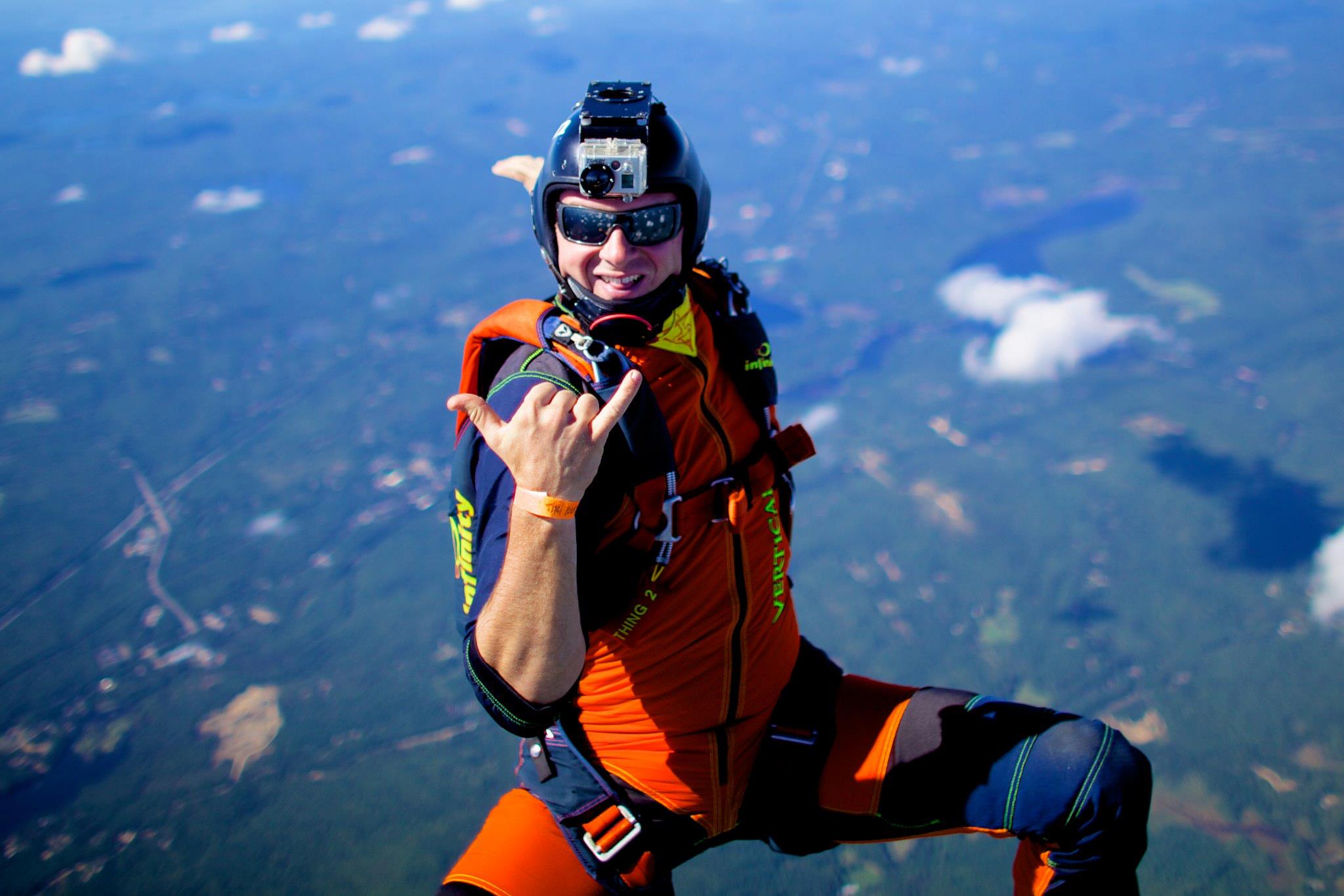After spending years as a professional skydiver, Rod Boden wasn’t sure how well he would fit in at business school when he arrived at Arizona State University in 2014.
But whenever he felt a bit overwhelmed, he was able to tap into some amazing inspiration — his great-uncle, W. P. Carey.
“I can’t turn my head without seeing his name everywhere,” said Boden (pictured above, right), who will graduate in May from the full-time MBA program.
“Being in a sea of all these bright young minds, any time I felt like I wasn’t quite as smart or quite as quick as everyone else in class, I would think of Bill and think that there was some small piece of him in me and that kept me feeling strong and motivated,” Boden said.
Boden has a family legacy that goes all the way back to the founding of ASU. He descends from John Samuel Armstrong, whose legislation launched Tempe Normal School, the precursor to ASU, in 1885. Armstrong’s grandson was William Polk Carey, a businessman whose foundation donated $50 million to ASU in 2003. The business school was then renamed William P. Carey and his likeness at the business school that bears his name. the W. P. Carey School of Business.
William P. Carey and his likeness at the business school that bears his name. the W. P. Carey School of Business.
“It’s a little overwhelming sometimes to think about the accomplishments of the people who came before me,” Boden said.
Earlier this month, he and his cousin, Doug Parvis, gave a presentation at the business school about Bill Carey and his brother, Frank, who is Boden’s grandfather.
Boden said the talk was something he had wanted to do for a while as a tribute to Bill Carey.
“We were just incredibly lucky that we got to be a part of this family and that we got to know the patriarchs of this family,” Boden said.
Great integrity
The Carey brothers had a tough childhood. Their mother married four times during a time when that was uncommon. They ended up living with their grandfather in Baltimore and showed an early aptitude for entrepreneurship — their first business venture was selling ink and soda pop out of their basement.
Frank went to Princeton, so Bill went there too. As a sophomore, Bill began buying secondhand refrigerators and renting them to students. The venture was enormously profitable but left little time for chapel or classes. He withdrew before he was kicked out and then enrolled in the Wharton School of Business at the University of Pennsylvania.
“He was humble along the way but always wanted to be the best,” Parvis said. “Whenever it was written about his education — Princeton and then Wharton — he never corrected people who assumed he had an MBA from Wharton.”
Frank Carey became a lawyer and eventually joined the company founded by brother.
Bill Carey started the International Leasing Co. at age 28 and later founded the W. P. Carey Co. investment firm. He was known as a humble but savvy businessman with great integrity.
Andy Rooney did a segment on “60 Minutes” about Bill Carey, describing how, as a young man, Bill was sent to a small town in Colorado to close a family sugar business that had failed. The sugar-beet farmers had worked for a year and were not paid because the business was bankrupted. Bill never forgot the farmers. Nineteen years later, he paid them.
In 1988, the W. P. Carey Foundation was formed to benefit education, and in 2003, it endowed the ASU business school.
“Of all the things he did, Bill was the most proud of his philanthropy,” said Parvis, who is on the board of the W. P. Carey Foundation.
A perfect fit
Rodney Carey Boden took a winding path to the spot that bears his family’s name.
After graduating with a degree in psychology from Johns Hopkins UniversityThe W. P. Carey Foundation also endowed the Carey Business School at Johns Hopkins. in 2008, he became part of a mobile response team in North Carolina, on call for 24 hours for people who were in danger of killing themselves. Boden said the work was rewarding, and he is proud of the fact that he was able to save five people from committing suicide.
“But that work takes a toll, and I started looking for a way out,” he said.
Rod Boden worked as a professional skydiver in Hawaii for several years before coming to ASU.
He had been skydiving for fun, and by 2011, he had more than 750 jumps. So he moved to Oahu, Hawaii, where he worked for Skydive Hawaii on the North Shore. He taught skydiving and shot video and photographs. He competed in the U.S. Nationals in canopy piloting, in which the jumper flies the parachute through an accuracy course.
“I was living on the beach, surfing every morning, skydiving all day, yoga in the afternoon or maybe another surf session. Rinse and repeat,” he said.
Idyllic as that was, he needed more. So he worked at a marketing start-up, using his video and photography skills for several companies as well as testing high-performance action cameras.
After a while, “I realized I was being undervalued. If I wouldn’t do it for cheap, they would find someone else to do it for cheap,” he said. “That’s when I realized it was time to re-enter the world.”
After taking the GMAT, Boden was headed back to the classroom, where the W. P. Carey School of Business’ marketing MBA program was a perfect fit.
At first, Boden didn’t advertise the fact that he is related to the school’s benefactor. “I didn’t want people to judge me based on anything other than who I am,” he said.
Boden has been happy to give back to the institution. One of his proudest moments was being elected president of the MBA Association, the student governing association for full-time MBA students.
He also was on the team that designed the Forward Focus MBA, and he helped to develop that new program’s cross-functional learning lab, in which students from different majors work as teams to solve problems.
After Bill Carey died in 2012, Boden inherited two mementos: a purple and green bow tie and a Tiffany watch. Last year, he started wearing the bow tie every Thursday, as a silent tribute to Bill and the motivation he inspired.
"I came into this wondering if I would fit in, but I realized that with the mix of all my experiences, and of me being me, that this was the perfect place for me.”
Top photo: Doug Parvis (left) and Rod Boden give a presentation about their ancestor W. P. Carey in McCord Hall on the Tempe campus April 12. Boden wore the bow tie he inherited after his great-uncle's death. Photo by Charlie Leight/ASU Now
More Business and entrepreneurship
Sustainability leader and ASU alum honored for transforming business with a people-first approach
Long before Jim Fish ('86 BS in accountancy) became president and CEO of WM — formally Waste Management — in 2016, he recognized that the higher he climbed the corporate ladder, the greater the…

ASU business students take on the big leagues
Each year, sports fans from across the country flock to Arizona to attend major events like the Waste Management Phoenix Open, Fiesta Bowl and Cactus League Spring Training. These mega-events…

With help from ASU and a viral TikTok, an entrepreneur soars
Nearly five years ago, Ruben Trujillo saw his entrepreneurial dream slipping away as he wondered how he would pay his rent.Now, Trujillo’s business, Café Emporos, is featured on a national TV…



